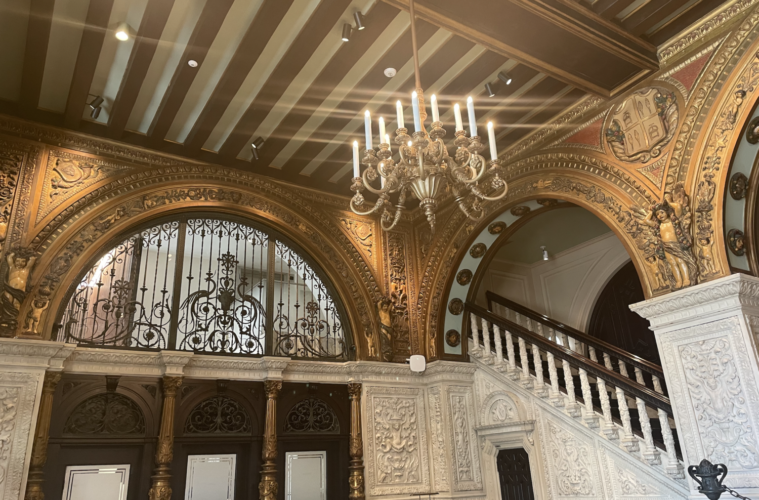Designed by William Randolph Hearst’s beloved architect Julia Morgan in 1914, who also helped create Hearst Castle and worked with the family for three generations, the crumbling L.A. Herald Examiner building on Broadway in downtown Los Angeles has undergone a $40 million renovation. It’s the new home of Arizona State University’s Walter Cronkite School of Journalism and Mass Communication state-of-the-art satellite campus.
The building’s stunning lobby entrance has been meticulously restored to its original splendor after years of neglect. The campus is home to Cronkite News’ L.A. Bureau, as well as video/audio editing bays, a broadcast studio, a 3D studio, classrooms, and a two-story event space. Plans for a restaurant on the street level are underway.
The plans for the space, which started well before the pandemic, already included fitting all the classrooms with virtual and Zoom capabilities, so students at the satellite campuses are one with the main campus in Phoenix and still have access to all the media opportunities L.A. has to offer. The 85,770 square foot space includes four floors and was designed by the L.A.-based Gensler architecture firm. The building was bought by The Georgetown Company in 2015 and worked on the redevelopment.
Additional ASU programs on the campus include the Sidney Poitier New American Film School in the Herberger Institute for Design and the Arts, Thunderbird School of Global Management, and Watts College of Public Service and Community Solutions.
Hearst founded the Los Angeles Examiner in 1903 and enjoyed its heyday in the 1940s, when they had a crime and scandal bent. The Examiner was the first to break the Black Dahlia story, with reporters arriving even before the police at the crime scene in Leimert Park and accessing evidence like her suitcase found in a locker at the L.A. Greyhound station, and owned the story.
One of the first at the murder scene was feisty and fearless reporter Agnes Underwood, who became news editor, one of the first women in the country to hold a city editorship on a major metropolitan daily. She worked as a reporter for the Los Angeles Record from 1928 to 1935, the Herald-Express from 1935 to 1962, and the Herald-Examiner from 1962 to 1968. In 1962, the Examiner and the Express merged to become the Herald Examiner, with both morning and afternoon editions.
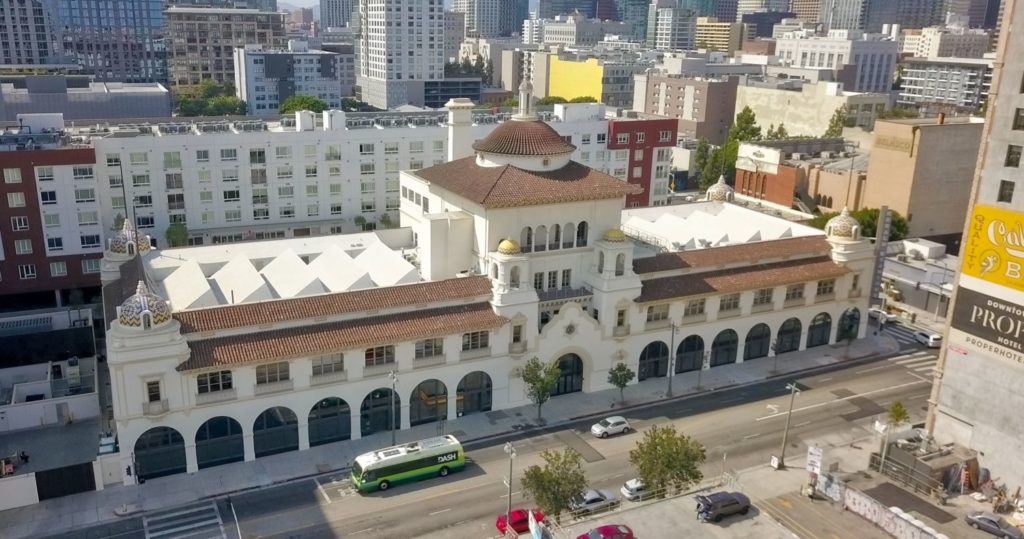
L.A. Herald Examiner building (Courtesy ASU)
In 1968, Herald employees began a labor strike that lasted almost 10 years and resulted in at least $15 million in losses. At the time of the labor strike, the paper’s circulation was about 721,000 daily and had close to 2,000 employees. The strike ended in March 1977, with circulation having dropped to about 350,000 and the number of employees to 700. There were numerous confrontations between pickets and strike-breakers, including violent incidents like the bashing of the copper handrails on the staircases between the newsroom and lobby. The dented remains were preserved in the renovation process, as a reminder of the paper’s tumultuous history.
During the 1980’s I worked across the street at the Associated Press in the paper’s annex, with many Herald staffers as colleagues. It was the cocky era of Page 2 gossip columnist Mitchell Fink, restaurant critic Merrill Shindler, then copy editor Ann Herold and photographer Dean Musgrove. The digital age and color photography in newspapers were just on the horizon.
And the newspaper bars. There was Corky’s, a dive across the street from the Herald, which saw its share of fisticuffs at closing time. It was located next to the Mayan Theater on Hill Street, (which was a porno theater at the time). The Redwood Room on Second Street was the Los Angeles Times watering hole, where on any given night you could catch the smoky aroma surrounding photographer Mike Meadows after a day of covering local fires. The story goes that the director of photography had a booth with an extension to his office phone at the Redwood Room. People would call him and he picked up the line in the bar, with them thinking he was at his desk. Tommy was the bartender at the Red Fox in what is now South Park, which had designated tables for the Herald, AP and UPI.
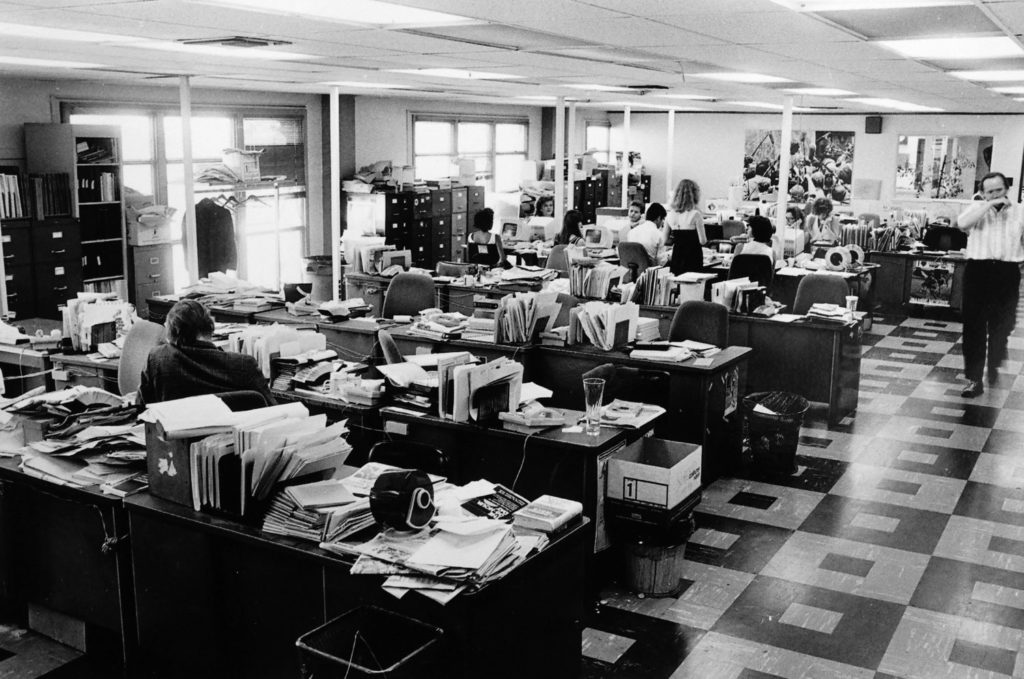
Photo editor James Roark walks through the Los Angeles Herald Examiner newsroom in the 1980’s. A John DeLorean trial photo by Mike Sergieff hangs on the back wall (Photo by Dean Musgrove)
I caught up with some of those seasoned former staffers, who shared their memories of the considerably alternative Herald Examiner with L.A. Weekly.
Ann Herold: After leaving the Herald, she was at the Los Angeles Times from 1983 to 2007, and was managing editor of the Times’ Sunday magazine for 16 years. She then became a managing editor at Los Angeles Magazine.
“For me, the joy of working there was that building. I already had a love for unusual architectural spaces from growing up in Santa Barbara and bonding with all the great architectural spaces there, from the courthouse to Lotus Land. So, to be in a Julia Morgan building that was distinguished by its architecture was so exciting. My favorite thing to do on my breaks was to go down into the lobby and just look around, even though at that point it was a mess. It was grimy, the paint had rubbed off. What it looks like now, it did not look like then at all. But there was enough left even in its crumbling state that you could sort of see the beautiful architectural detail.
“The working conditions themselves in the upper floor where the newsroom was were grim. The linoleum was peeling. I was cautious to sit on the chairs because I was afraid they were going to collapse. It was hard to find one where the spring wasn’t popping up through the cushion.
“Still, it was really fun to work in that space. It was exciting and inspiring, working for Mary Anne Dolan. She was the first woman editor of a major American newspaper, and came from the Washington Post, so she had this incredible east coast journalism credibility and she was married to maverick TV exec Brandon Stoddard. It was such a great building, and to see it again all these years later in such an exciting state of beauty, is just glorious. You always fear those historic spaces are going to be lost when they are allowed to languish the way they were at the time that I worked there; you worry it’s going to reach the point of no return. I never expected it to be restored to that extent.”

The updated newsroom at the ASU Walter Cronkite School of Journalism and Mass Communication state-of-the-art satellite campus.
(Michele Stueven)
Mitchell Fink: Started his journalism career at the Herald Examiner in music in 1978, later became the paper’s Page 2 gossip columnist and went on to create the Insider Column at People Magazine. A successful TV career followed that, with stints on CNN’s Showbiz Today and Access Hollywood.
“I started at the Herald in April of 1978. I made myself so visible. Every time they needed somebody to interview someone or review a show, I did it. And each time I’d get $35 for this and $50 for that. A little time went by and we started the sound section under the editorship of Jim Bellows. No story about the Herald Examiner can be written without the mention of Bellows. They pretty much brought him on to help save the paper. There was no editor like him. He wrote a book called ‘The Last Editor.’ When he was at the Herald, he invented writers like Tom Wolfe and Jimmy Breslin, and went on later to develop Entertainment Tonight.
“The music business was exploding, with billboards on Sunset Boulevard in 1978 plastered with the Bee Gees and other acts. I was a music guy and I was exploding with it, interviewing rock stars. The Who, The Beach Boys, it was endless. I’d go on the road with Crosby, Stills and Nash.
“I remember one experience I had with The Who and Ken Tucker, who was reviewing them in San Diego. I waited around because I had to interview Pete Townsend after the gig. We waited about two hours and Townsend finally agreed to see me. He wouldn’t allow me to take a notebook in, I had no tape recorder. I went into the interview with nothing. So I’m sitting in the men’s bathroom on the floor in a dry shower with Pete Townsend. His hand is bleeding from killing his guitar. He’s telling me how he can’t take this anymore and he’s ready to pack it in, which of course he never did. I had an incredible story, and I remembered some of the things he said and I was able to paint a picture of what it was like to be on a cold tile floor with Pete Townsend.
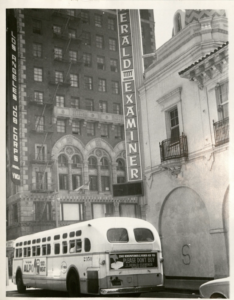
L.A. Herald Examiner strike (Courtesy Los Angeles Typographical Union/Special Collections & Archives at CSUN)
“We got back to the car with photographer Chris Gulker and the car blew up. We had no way to get back. We needed to wait for rental places to open. During this time of waiting in the middle of the night, Gulker tells us, ‘You know, this wouldn’t happen to us if we were at the L.A. Times. They provide cars.’ We finally get back after no sleep at all and I have to write a story on the Who, Tucker’s got to do his review of the group and Gulker has to process his film on bloody stumps. Bellow’s door was open and I went in. I told him about that extraordinary night and complained that the L.A. Times supplies cars. He looks at me and says, ‘Well, you will never, ever have as much fun over there as you have here.’ And that was the truth.”
“So it’s 10 years later and I’ve gone from music, to Q&A editor. One day I’d be interviewing Mickey Mantle and the next day the shoe shine guy from the state capital. Then years after Bellows, Harry Rosenfeld became the editor. If you go back to the movie ‘All The President’s Men,’ he was the Jack Warden character. He came in and killed the Q&A, and my choices were general assignment reporter or I was out.
“I became a general assignment reporter and hated it. It was so painful, going to south central Los Angeles after a murder. I knew what the Herald wanted – a picture of the grieving widow, sitting holding a photo of the deceased. People would let me in and I wondered why. They let me in because they knew that a story in tomorrow’s paper would somehow give some meaning to their lost loved one.
“It was painful and when the chance came to do the gossip column, called Page Two, I jumped at it. Greg Kilday, who went on to the Hollywood Reporter, was doing Page 2 and decided to leave, so I applied for the job. I got it and it was an incredible run.
“I loved the Herald Examiner and what we were all about, and I never thought for a minute in that entire run that I had about the strike or how it affected things. I know the Herald was bleeding money every month, but a newspaper closing in 1989 was a really big deal. I was there until the very last day when the paper folded, and ended up qualifying for a pension, which I continue to receive every month. It’s not a lot, but it’s better than a poke in the eye.”
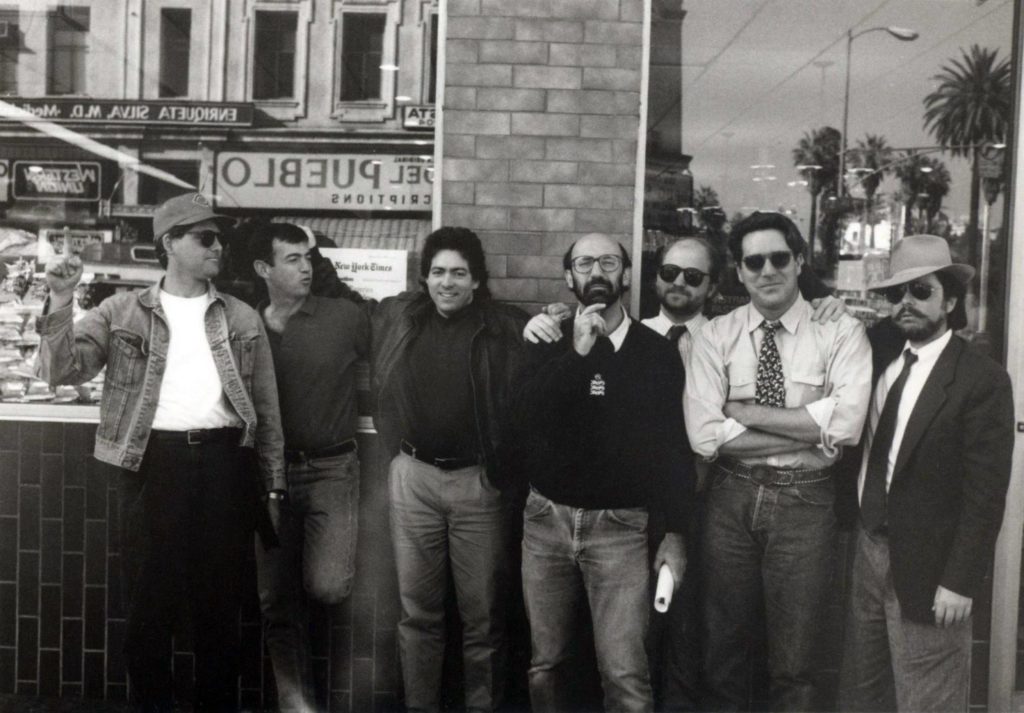
From left: Chas Fleming, Bill Higgins, Lifestyle Editor Jerry Lazar, Merrill Shindler, Russ Parsons, Richard Rouillard, and John Desimio at Langer’s Deli.
(Courtesy Jerry Lazar)
Merrill Shindler: Radio host and roving restaurant critic for the Southern California News Group that includes The L.A. Daily News, San Gabriel Valley Tribune and Torrance Daily Breeze
“I came down from San Francisco after working at Rolling Stone and the alternative Bay Guardian looking for a job, and went down to the legendary, great Herald building filled with wonders downstairs. Upstairs it just looked like a newsroom – a newsroom that looked like nobody had cleaned it in a long time, that is. I spoke to the editor, Jim Bellows, and next thing I knew, I was the restaurant critic for the Herald Examiner, where I worked from 1979 to 1989, when they pulled the plug.
“It was such great fun being there. I know it’s a cliche, but the inmates really were running the asylum. I’d pick up buckets of mail and spend a whole day opening up press releases. Nobody ever told me where to go or what to do or write. It was zany and sort of like, if you don’t bother us, we won’t bother you. I was happy to be there because the Times was so stodgy, and stiff and serious. I used to say the L.A. Times is the newspaper that wishes it wasn’t in Los Angeles. It doesn’t like Los Angeles and the Herald Examiner is all about Los Angeles. It was gritty and funky, and weird and largely out of control. You never knew on any given day what would happen.
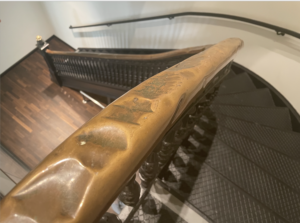
Banged up bannister (Michele Stueven)
“It never paid very well, but I didn’t care. I was writing for Casey Kasem’s Top 40 radio program and the film critic for Los Angeles magazine at the time. But getting to go to restaurants around town was great. Unlike the L.A. Times, I didn’t stick with the nicer places. This is a city of grit and eccentricity, and I’d venture out to the San Gabriel Valley and the further ends of the San Fernando Valley, and find worlds like Cambodia town in Long Beach and the Vietnamese communities few knew about and the rise of a new Chinatown. I think I was the first person to write about the first Chinese seafood restaurant popping up in Monterey Park. They were like, ‘You’re a grownup, go write about something and try to spell words right and try to get the address right.’ I rarely got a call from anyone complaining about my copy, which made me suspect that nobody was actually reading it. It was a seat-of-the-pants publication and it was great.”
Dean Musgrove: Herald Examiner photographer, currently Visuals Editor at the Southern California News Group
“When I started in May of 1978, the average staff size was about 13 staff photographers, and the L.A. Times in those days probably had about 25, plus a bunch of photo editors. We all pretty much covered the same things. I’d have assignments in Tijuana or would have to drive to Sacramento for an assignment. We were mostly L.A.-based, because there were so many other community papers at that time. We left those local stories to them.
“In the photo lab, before things went digital and they had barely gone digital when the paper closed, digital cameras weren’t in there yet, we were still making prints in the big darkroom and had to turn on the water to rinse the prints. Well, the plumbing and the pipes were so bad that the water ran 24/7. The walls were thick concrete and to send a plumber in to do a job was impossible.
“Everybody was going to color in the ‘80s. The Daily News invested about $60 million and the Times invested heavily into their color capability, and the Orange County Register was ahead of everybody. They won a Pulitzer for their Olympic coverage, largely because it was all in color. It’s 1984 and here we are doing a little spot color or farming it out to be printed elsewhere. The Herald had nowhere to go to invest in what was needed downtown to build new presses. You can’t shut down the presses to install new ones. That was kind of the beginning of the end. They couldn’t get the revenue to justify the expense of capital improvements. They put us up for sale, but nobody was buying it. Even the union was trying to get a group of investors to buy it. Slowly you started seeing more people leaving.
“I was always at the paper at 7 o’clock in the morning. I remember standing at the window with my cup of coffee looking down on the parking lot and I saw a white limo pull into the driveway. You didn’t see a lot of shiny white limos pulling into the parking lot at 7 a.m., 1989. I recognized one of the heads of Hearst in New York getting out of the car. I called somebody I knew at the Daily News and the L.A. Times and told them I thought something was going to happen that day.
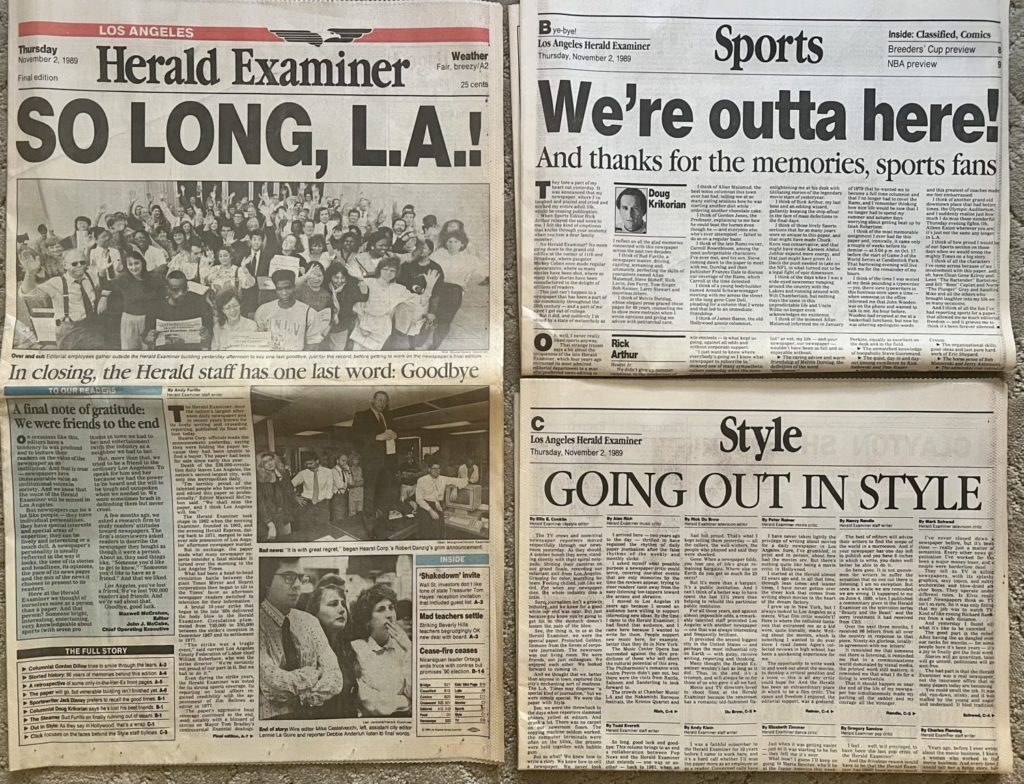
Herald Examiner final edition (Courtesy Dean Musgrove)
“Then at 9 a.m., the head of Hearst Newspapers, Robert Danzig, came in and stood on the desk in the newsroom and announced the closure. People were crying and hugging, trying to get a hold of their spouses and families. It was incredibly chaotic and emotional. But we’re still reporters and photographers, so everybody is in a frenzy writing their farewell columns. We ran out and got this huge A-frame ladder and had everyone come out to the front of the building for a ‘So Long, L.A.’ picture that would be the Page One art for the next day’s final edition. We had to take the ladder out onto Broadway and I’m in the middle of the street waving the buses past so we could take the picture. Then later on in the day, one of the editors said we’re missing a bunch of people and have to redo the picture. So we went and did the whole thing all over again, with me waving the traffic all over the place.
“But that was just an example of what I loved the most about the Herald. That team spirit of welcomed brainstorming from all departments and staff levels, and that ‘we can do it against all odds’ attitude.”
Thanks to AP cohorts Reed Saxon, Herb Hemming, Doug Pizac and Nick Ut for their contributions and memories.
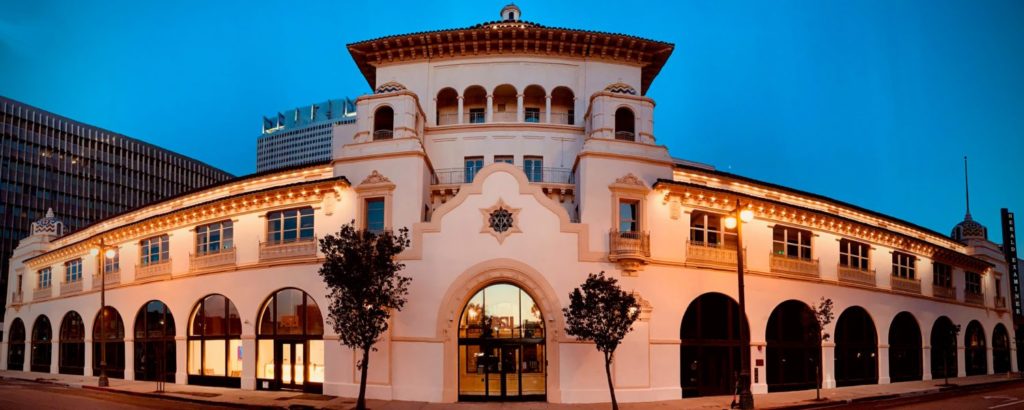
Courtesy Arizona State University
Editor’s note: The disclaimer below refers to advertising posts and does not apply to this or any other editorial stories. LA Weekly editorial does not and will not sell content.
Advertising disclosure: We may receive compensation for some of the links in our stories. Thank you for supporting LA Weekly and our advertisers.

